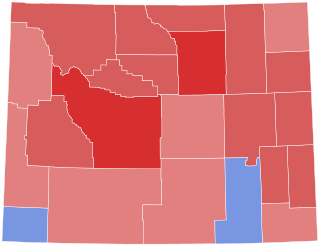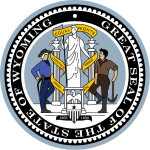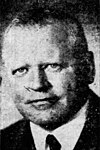
The 1990 Wyoming gubernatorial election took place on November 6, 1990. Incumbent Democratic Governor Mike Sullivan ran for re-election. In the general election, he faced Republican nominee Mary Mead, a businesswoman and the daughter of former U.S. Senator and Governor Clifford Hansen. Owing to Sullivan's personal popularity, he won re-election over Mead in a landslide, marking the fifth straight Democratic victory in Wyoming's gubernatorial races, a streak that has yet to be broken by either party.

The 1982 Wyoming gubernatorial election took place on November 2, 1982. Incumbent Democratic Governor Edgar Herschler ran for re-election to a third term. He faced former State House Speaker Warren A. Morton in the general election after several prominent Republicans, including then-Congressman Dick Cheney, declined to challenge him. However, Herschler remained personally popular and the national political environment favored Democrats, and he had little difficulty defeating Morton to win a third term. In doing so, Herschler became the first Governor of Wyoming to win three terms in office.

The 1962 Wyoming gubernatorial election took place on November 7, 1962. Incumbent Democratic Governor Jack R. Gage, who ascended to the governorship after his predecessor, John J. Hickey, appointed himself to the U.S. Senate in 1961, ran for re-election. After beating back a strong challenge from former Secretary of State William M. Jack in the Democratic primary, he then faced Republican nominee Clifford Hansen, the President of the University of Wyoming Board of Trustees and a former Teton County Commissioner.

The 1954 Wyoming gubernatorial election took place on November 2, 1954. Incumbent Republican Governor Clifford Joy Rogers ran for a full term as Governor of Wyoming after Frank A. Barrett was elected to the U.S. Senate, but lost the nomination to former State Representative Milward Simpson. Simpson narrowly defeated Democratic former Secretary of State William Jack in the general election.

The 1950 Wyoming gubernatorial election took place on November 7, 1950. Incumbent Republican Governor Arthur G. Crane, who ascended to the governorship when Lester C. Hunt was elected to the Senate in 1948, declined to seek re-election. Congressman Frank A. Barrett won the Republican primary to succeed Crane and faced former State Auditor John J. McIntyre, the Democratic nominee, in the general election. Helped by the strong performance nationwide of the Republican Party, Barrett defeated McIntyre by a wide margin. This election was the first open-seat gubernatorial election in Wyoming since 1924.

The 1946 Wyoming gubernatorial election took place on November 5, 1946. Incumbent Democratic Governor Lester C. Hunt ran for re-election to a second term. Former Republican Governor Nels H. Smith, whom Hunt defeated in 1942, announced that he would challenge Hunt for re-election, but he was defeated the Republican primary by State Treasurer Earl Wright. In the general election, even though the Republican Party had a strong performance nationwide, Wyoming Democrats did well; Hunt defeated Wright by a wider margin than his 1942 victory as Democratic U.S. Senator Joseph C. O'Mahoney similarly won another term.

The 1942 Wyoming gubernatorial election took place on November 3, 1942. Incumbent Republican Governor Nels H. Smith ran for a second term as governor. After defeating several opponents in the Republican primary, he advanced to the general election, where he was opposed by Lester C. Hunt, the Wyoming Secretary of State and the Democratic nominee. In a reversal from Smith's landslide election in 1938, Hunt narrowly defeated him in his attempt at a second term.

The 1918 Wyoming gubernatorial election took place on November 5, 1918. Following the election of Governor John B. Kendrick to the U.S. Senate in 1916, Secretary of State Frank L. Houx served as acting Governor. He ran for re-election and faced a stiff challenge in the Democratic primary from attorney William B. Ross. After defeating Ross by a decisive margin, he faced Robert D. Carey, the Republican nominee and the son of former Democratic Governor Joseph M. Carey. However, despite Houx's past electoral success, he faced difficult headwinds as Democratic candidates did poorly across the country in 1918. He ended up losing re-election to Carey by a wide margin.

The 1930 Wyoming gubernatorial election took place on November 4, 1930. Incumbent Republican Governor Frank Emerson ran for re-election. As was the case with Emerson's first election in 1926, he faced a tight race. He was opposed by State Senator Leslie A. Miller, the Democratic nominee. Ultimately, Emerson narrowly won re-election over Miller, winning 51-49%, and by a margin of just 870 votes. However, Emerson did not end up serving his full term; he died on February 18, 1931, just a few weeks into his second term, triggering a special election in 1932.

The 1932 Wyoming gubernatorial special election took place on November 8, 1932. Just several weeks into his second term, Republican governor Frank Emerson died in office. Secretary of State Alonzo M. Clark ascended to the governorship, and a special election was called for 1934. Clark ran for re-election, but was defeated in the Republican primary by State Treasurer Harry R. Weston. Meanwhile, former state senator Leslie A. Miller, the unsuccessful Democratic nominee against Emerson in 1930, once again ran for the office and won the Democratic primary. In the general election, another close election ensued. But Miller, likely aided by Franklin D. Roosevelt's strong performance in Wyoming in that year's presidential election, narrowly defeated Weston to win his first term as governor.

The 1938 Wyoming gubernatorial election took place on November 8, 1938. Incumbent Democratic Governor Leslie A. Miller ran for re-election to his third term, and his second full term. Nels H. Smith, a former State Representative and former state highway commissioner, won a crowded Republican primary and advanced to the general election against Miller. Though Miller won his re-election campaign four years earlier in a landslide, Smith was able to take advantage of the nationwide Republican wave to defeat him in a landslide, winning 60% of the vote to Governor Miller's 40%.

A general election was held in the U.S. state of Wyoming on Tuesday, November 2, 2010. All of the state's executive officers—the Governor, Secretary of State, Auditor, Treasurer, and Superintendent of Public Instruction—were up for election.

The 1934 United States Senate elections in Wyoming took place on November 6, 1934. Incumbent Democratic Senator John B. Kendrick died on November 3, 1933, and Joseph C. O'Mahoney was appointed by Governor Leslie A. Miller as Kendrick's replacement. Two elections for the same Senate seat were held on the same day; one as a special election to fill the remainder of Kendrick's original six-year term, and another to select a Senator to serve the next six-year term. O'Mahoney ran for re-election in both elections. He was opposed by Republican Congressman Vincent Carter. Aided by the strong performance by the Democratic Party throughout the country in 1934, and by Governor Miller's landslide re-election, O'Mahoney handily defeated Carter to win re-election.

A general election was held in the U.S. state of Wyoming on Tuesday, November 2, 1926. All of the state's executive officers—the Governor, Secretary of State, Auditor, Treasurer, and Superintendent of Public Instruction—were up for election. Republicans narrowly picked up the governorship and solidified their control on the other statewide offices, increasing their margin of victory in each race.

A general election was held in the U.S. state of Wyoming on Tuesday, November 4, 1930. All of the state's executive officers—the Governor, Secretary of State, Auditor, Treasurer, and Superintendent of Public Instruction—were up for election. Republicans narrowly held onto the Governor's office and won every other state office.

A general election was held in the U.S. state of Wyoming on Tuesday, November 6, 1934. All of the state's executive officers—the Governor, Secretary of State, Auditor, Treasurer, and Superintendent of Public Instruction—were up for election. In the 1932 gubernatorial special election, the Democratic candidate, Leslie A. Miller, won and ran for re-election for a full term in 1934. The Democratic Party also won elections for Secretary of State, Auditor, Treasurer, and Superintendent of Public Instruction, flipping those offices from the Republican Party.

A general election was held in the U.S. state of Wyoming on Tuesday, November 3, 1942. All of the state's executive officers—the governor, secretary of state, auditor, treasurer, and superintendent of public instruction—were up for election. Like the 1938 elections, this year's elections were something of a mixed bag for both parties. Democratic secretary of state Lester C. Hunt successfully defeated Republican governor Nels H. Smith for re-election, but Republicans flipped the secretary of state's office in Hunt's absence. The other incumbents—State Auditor William M. Jack, a Democrat, and Superintendent Esther L. Anderson, a Republican—were re-elected, and Republicans held onto the state treasurer's office.

A general election was held in the U.S. state of Wyoming on Tuesday, November 5, 1946. All of the state's executive officers—the governor, secretary of state, auditor, treasurer, and superintendent of public instruction—were up for election. The election was largely a rout for the Republican Party. Though Democratic governor Lester C. Hunt was narrowly re-elected, Democrats lost their two other state offices: auditor and secretary of State. Moreover, they were unable to win back any other state offices.

A general election was held in the U.S. state of Wyoming on Tuesday, November 6, 1990. All of the state's executive officers—the Governor, Secretary of State, Auditor, Treasurer, and Superintendent of Public Instruction—were up for election. Democrats Mike Sullivan and Kathy Karpan were re-elected as Governor and Secretary of State by landslide margins, while Democrat Lynn Simons was defeated for re-election by Republican Diana Ohman. Republicans also continued their winning streak in the elections for State Auditor and State Treasurer.

A general election was held in the U.S. state of Wyoming on Tuesday, November 7, 1922. All of the state's executive officers—the Governor, Secretary of State, Auditor, Treasurer, and Superintendent of Public Instruction—were up for election. Democrats improved considerably from their performances in 1918, with William B. Ross winning the gubernatorial election and almost all of their statewide candidates outpacing their 1918 nominees. However, Republicans held all of the other statewide offices.
















